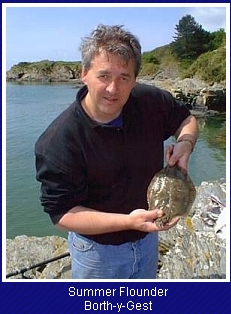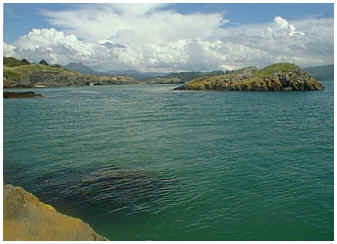|
The
area covered is from the sluice gates in Porthmadog
to the point known locally as the Powder
House.
The Powder House is close to where the river meets the open
sea. From the sluice to the Powder House is a total distance of
approximately 1½ miles.
Approximately
1 mile from the sluice gates the river Glaslyn is joined from the left
(the Portmerion side of the estuary) by the river Dwyryd and generally
speaking this last ½ mile offers the best chance of a large bass,
unfortunately it is also a Mecca for jet skiers and water skiers in the
summer especially at weekends and in school holidays. If you want to
fish here your best option by far is a night session or midweek trip
outside of school holidays.
Marks:
Sluice Gates and Harbour
Borth-y-Gest & Danger Rock
Powder House
Bait:
Peeler or soft back crab:- available from the shop in season
Lugworm:- Can be dug behind the Ffestiniog Railway.
Harbour Rag:- Can be dug in the mud directly behind the Ffestiniog
Railway, also plentiful from mud at Borth-y-Gest
Lures:- available thru the shop.
For some reason fresh bait is a must for fishing the estuary.
The harbour, the road bridge and
the and sluice gates can all be fished at either high or low water depending upon the species your
targeting.
Bass
If you want to target the bass
right in town itself then I suggest a
summer time spring tide when high water falls between midnight
and 2am. The killer tactic is to fish from sluice gates side of the
harbour bridge just as the tide begins its ebb. You fish from the bridge
itself using light gear and smallish hooks, size 4 is plenty big enough,
you free line or use a small float or a small swan shot weight aiming to get your bait fluttering
near the waters surface right under the bridge itself. The best bait is
bunches of 4 or 5 harbour ragworm. If there are any bass around it won't
take long to get a few using this method. The bass here are only
usually school bass up to a maximum of 3lbs although the occasional
larger fish will be taken.
My own experiences fishing for bass elsewhere in harbour have been quite
fruitless. The bridge for some reason offers the best chance of catching
bass.
Mullet
At low water very large mullet some easily 8lb -10lbs cruise the
shallows in and around the harbour. On calm summer days the bow waves
they make as they move through these shallows are visible all over place
there are so many fish.
The fish really become a viable target for anglers for 2hrs around low
water. The best bait is bread and the fish can be caught with
patience. About an hour or so after low water when the flood tide
begins the fish start to move and are more difficult to contact.
For this style of fishing a pair of polarised sun glasses are a must.
Flatfish
For some reason flatfish aren't as abundant as they once were in the
harbour, indeed the same is true for the whole estuary. Having said that
they can still be caught just not in the same numbers. You best chance
of taking fish is on the incoming tide fishing over the clean sand just
after the tide covers it, the small beach off
the corner of Snowdon
Wharf was a one time favourite mark. Use light tackle with
plain leads and small hooks baited with fresh harbour rag worm.
Eels
Eels will turn up anywhere and everywhere. The snaggy ground by the
sluice gates is a favourite spot. The eels are most active on summer or autumn nights when HW
occurs after sunset. Fish 2hrs
either side of high water using large lug worm, crab or lob worm
baits. The eels a generally quite small with only very occasional fish over
2lbs.
back
to top
Warning:
The poisonous weaver fish is
quite abundant in
the estuary during the summer so be careful not to
grab one thinking it's a small bass!
On all but the largest spring tides the estuary
down to the powder house can be fished with light tackle, carp or
pike rods with line of 10-15 lbs. Weights should be in the 60
to 90gm range and even lighter for the 2hrs around high or the 2
hours around low water.
Borth-y-Gest, (map)
Danger Rock and Samson's Bay (map)
 Borth-y-Gest is a small
village situated ¼ of a
mile from Porthmadog's main harbour, it lies just beyond the the headland
where Porthmadog's dockside buildings end. It surrounds a small a small
muddy u-shaped bay off the main estuary. By car from Porthmadog you follow
the signs for Black Rock Sands, just as you reach the
top of the hill on the edge of town you take a left hand
turn sign posted for Borth-y-Gest. Follow this road for a ¼ mile and
park in the public car park. Borth-y-Gest is a small
village situated ¼ of a
mile from Porthmadog's main harbour, it lies just beyond the the headland
where Porthmadog's dockside buildings end. It surrounds a small a small
muddy u-shaped bay off the main estuary. By car from Porthmadog you follow
the signs for Black Rock Sands, just as you reach the
top of the hill on the edge of town you take a left hand
turn sign posted for Borth-y-Gest. Follow this road for a ¼ mile and
park in the public car park.
From
the car park it's possible to walk the full
length of the estuary to the Powder House following the coastal path a
distance of approximately 1¼ miles. The coastal path follows the edge
of the estuary most of the way. Anywhere
along the estuary offers the chance of decent bass although from
confluence of the Glaslyn and Dwyryd
your chances of a big fish increase. Following
the coastal path down the estuary you'll find plenty of small beaches
with cliffs and rocks at the high water mark, you can fish any off these
marks from low water casting into the river channel right up to high
water and back down again if you so wish. Tackle can be kept light in all but the largest spring tides so carp
style rods are fine. A productive method is to fish a plain lead
so that the current slowly moves it, this will normally need
a range of weights from 1½ ozs up to 3ozs depending upon the state of
the tide. No complicated rigs are
needed just use a simple running ledger with about 12" - 18"
hook length. Hooks themselves can be kept small size 2 or 4 when using
harbour rag with larger sizes for lug worm or crab. The
best bait is peeler crab as it sorts out the better sized fish but if
crab isn't available then bunches of harbour rag or single lug worm will
catch fish. Normally the bass and flatfish will be
most active when there's some tidal movement. The hour either side of
high water is often a quiet spell when the bait robbing crabs are the
only things willing to play.
In summer and especially during school
holiday the beaches can be very busy during the daytime so a night
session is best. Jet skiers aren't so active this far up the estuary so
they shouldn't be a major problem. You'll usually only encounter
them further down towards Samson's Bay. There
are 2 rocks jutting out into the estuary which become Islands at high
water, known locally as 'The First Danger Rock' and 'The Second Danger
Rock' so called because both have life saving apparatus on them. The
First and The Second prefixes simply refer to the order in which you
encounter them as you travel down the estuary towards the
sea. Anywhere
from The First Danger
Rock down to Samson's
Bay (local names) offer you an excellent chance of that specimen bass. This
is the area where the rivers Glaslyn and Dwyryd
meet. Both Danger Rocks offer a
good spot for fishing the channel at low water and a few hours into the
flood but take care if you do as the both become islands at high water.
The island shown in the foreground of the picture is The Second Danger
Rock and the island just visible in the distance is the First Danger
Rock. From the spot where the picture was taken is a small rocky
headland just beyond The Second Danger Rock where strong currents come
close to the base of the rocks making it ideal for the bass. There are also some huge mullet to be seen
and which feed right at the foot of
the rocks, but this far down the estuary they are very wary and easily
spooked. Landing a large fish at this mark is easier and less risky if
you've got a landing net. You'll
get small school bass with occasional flounder using harbour rag, with
better fish on peeler or soft back crab. The estuary has many marks
which look as though they'd offer some good lure fishing but this is
something not many people seem to practice here. If the
jet skiers or the water skiers are active then you might as well find
another mark. back
to top
A great spot early or late season before water
skiers and jet skiers become too active, but having said that their
season seems to get longer each year so to avoid them fish mid week if
you get the chance. The estuary is
actually quite narrow here at low water and this is when to fish this
mark. Every bass, flounder, sea trout or salmon entering the estuary
will have to pass through this narrow stretch of
water. This is a low water mark
fished 2 hrs either side of low water. Access to the mark is either by
driving along the beach and parking as close as possible to the estuary
or parking close to the Golf Club and walking along the public right of
way. Be careful the closer you get to the estuary sand can become quite
soft. Access to the beach is controlled during the summer months and the
gates to beach locked at night. Early season and late season the gates
should remain open. Like the rest
of the estuary bass and flatfish will be your target species. Carbs will
out score all baits with harbour rag and lug a close second. A
really nice spot early morning mid week in the summer when there's no
water or jet skiers and only the occasional boat passing by.
back
to top
|
